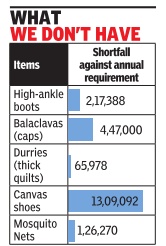Defence expenditure, defence economy: India
This is a collection of articles archived for the excellence of their |
Contents |
Defence expenditure of India
1914-2018

From: Sep 6, 2019: The Times of India
See graphic :
The world’s top military spenders in 1914, 1939, 1975, 1990, 2010, 2018
2010-20/21
Armaan Bhatnagar, January 30, 2021: The Times of India
India's defence spending in 7 charts
NEW DELHI: Defence allocation is expected to be a key focus area of Budget 2021 amid wide expectations of a significant hike to tackle the threat posed by China.
Last year, the government had set aside Rs 4.71 lakh crore for the defence sector, with capital outlay — required for miliary modernisation — witnessing just a marginal increase.
This year, however, the defence sector is eyeing a generous capital infusion amid a heightened need to strengthen the military infrastructure in view of the ongoing border conflict with China.
With just two days left for finance minister Nirmala Sitharaman's budget presentation on February 1, we look at how the government has been spending on defence over the years ...
Last year, the government's allocation to the defence ministry was the highest among all ministries at 15.5% of the total budget expenditure.
India's overall defence spending has witnessed an average growth rate of 9% in the last 10 years.
If the government sticks to this trend, at the very least the defence budget this year would likely exceed the Rs 5 lakh crore-figure.
However, in terms of military reforms and modernisation, all eyes will be on the funds allocated for capital expenditure.
Army biggest stakeholder
The Indian Army, with its overwhelming size, continues to be the biggest stakeholder in the defence budget among the three forces.
In last year's budget, almost 56% of the total defence outlay was earmarked for the Indian Army. The Air Force and Navy were allocated 23% and 15% respectively.
But the interesting thing here is that the Army's capital share was the lowest among the three forces.
Out of the total amount allocated for the Army, only 18% constituted capital expenditure while the rest was meant for revenue expenditure
Revenue expenditure includes expenses on payment of salaries and maintenance of establishments while the capital expenditure involves the purchase of new weapons, platforms and military hardware.
According to Institute for Defence Studies and Analyses (IDSA), the Army's capital share has been on a constant decline over the last few years since the high of 26% in 2007-08.
Meanwhile, the Air Force's capital share was the highest at 59% on the back of the government inking big-ticket deals to bolster India's air power.
Defence as proportion of GDP
Despite a nominal year-on-year growth rate, the defence budget appears to be somewhat underwhelming when viewed as a proportion of India's Gross Domestic Product (GDP).
According to last year's figures, the overall defence budget was just 2.1% of the then estimated GDP. This was the lowest figure since the early 1960s.
In fact, over the last few years, India's defence budget as a proportion of its GDP has been on a decline.
Military experts believe that India should allocate at least 2.5% of its GDP to defence expenditure for building requisite deterrence against China and Pakistan.
Slow pace of modernisation
The modernisation of India's 1.5 million strong armed forces has witnessed slow progress in the last few years due to ballooning salary and pension bills.
In 2010, salaries and pension took up nearly half the total defence budget at 49%. This increased by 10 percentage points to 59% in 2019.
According to IDSA, the rising manpower cost has posed a hindrance to the much-needed modernisation of military.
In last year's budget, the capital outlay for new weapon systems and defence modernisation was Rs 1,18,555 crore, much lower than the Rs 2,18,998 crore revenue expenditure for day-to-day running costs, salaries and the like.
NDA vs UPA
As a proportion of the total budget expenditure, India's defence spending was the highest in 2000-01 under the then Atal Bihari Vajpayee government at 16.73%.
The Manmohan Singh-led UPA government began its term by setting aside a handsome chunk for the armed forces in its first couple of years. But the proportionate spending fell to an average of 13% in its later years.
Similarly, the Narendra Modi government set aside an average of 12% of the total budget for defence in its initial years. However, the proportion fell to 11.62% in 2018 and then further to 10.96% in 2019, the lowest in the last two decades.
Last year, the spending picked up again when the defence ministry was allocated the highest sum among all the other sectors at 15.5% of the total budget expenditure.
Pay, pensions, personnel: 2013-22
June 17, 2022: The Times of India

From: June 17, 2022: The Times of India
The primary aim of the Agnipath scheme, under which jawans are to be recruited for four years, is to bring down the government’s expenditure on military salaries and pensions. That is expected to free up much-needed funds to modernise the armed forces and give India a leaner and younger fighting force.
While expenditure on defence, like all other expenses, has increased, so has the size of the economy. Data from Union budgets, analysed by Atul Thakur, shows in the past few years, the share of pensions in the overall defence outlay — which increased dramatically after OROP (One Rank One Pension scheme) — has actually seen a slight decline and might stabilise in the future
Defence expenditure of India, China, major countries
2017
Defence spend as percentage of GDP has fallen world over, March 26, 2018: The Times of India
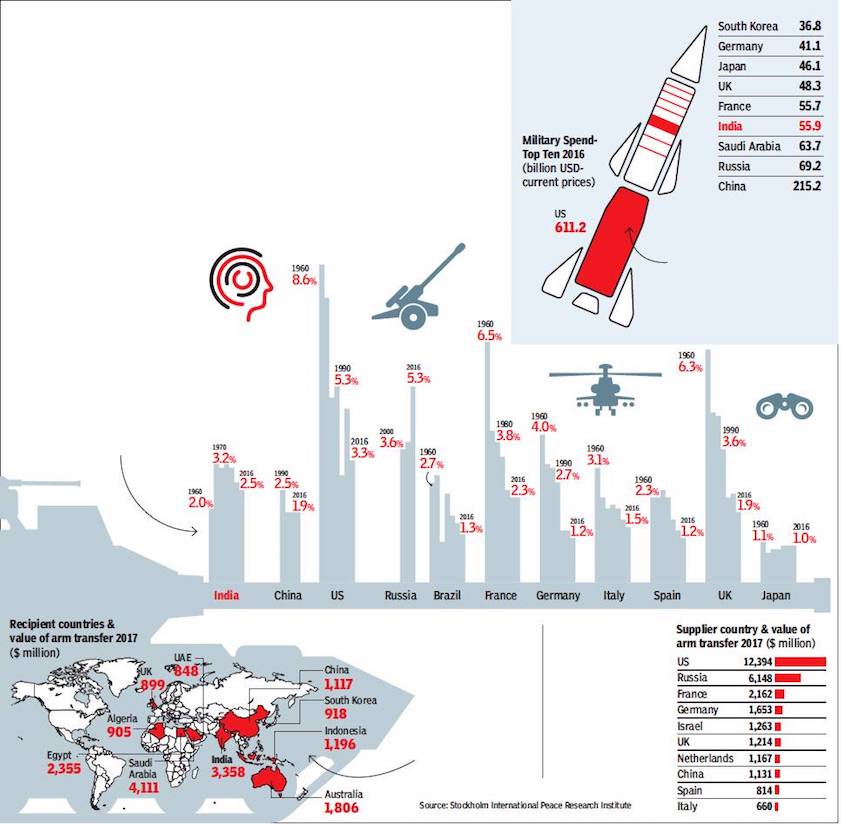
Defence expenditure as a percentage of the GDP
Defence expenditure in absolute terms
The major arms suppliers
The major arms recipients
From: Defence spend as percentage of GDP has fallen world over, March 26, 2018: The Times of India
India’s defence forces have expressed unhappiness over the allocation for them in the Union Budget which, at 1.56% of the GDP, was the lowest since 1962, when India and China fought a war. But the defence budget as a part of the GDP has actually been shrinking across the world...
Is India the only country whose defence bill as percentage of GDP has reduced?
• Government allocated Rs 2.74 lakh crore for defence in the 2018 budget. This will amount to 1.56% of the country’s GDP, making this allocation the lowest ever in terms of share of GDP. The analysis of budget allocations as a percentage of GDP for other major economies shows a similar pattern. As an economy grows, the proportion of its defence expenditure as compared to its overall size is bound to fall. This pattern is followed in most of the countries.
Are these countries making their own armaments?
• No. Many of these countries that top defence expenditure are dependent on import of defence equipment. In 2017, India was the world’s second-largest ar ms importer.
Which are the world’s largest arms suppliers?
• US followed by Russia are the world’s largest arms suppliers. Together they dominate the global arms market by a huge margin as compared to other countries.
In absolute terms, which country spends the highest on defence?
• US by far spends the highest on its defence. America’s total defence expenditure is roughly equal to the defence expenditure of the next nine highest- spending countries.
2019
Armaan Bhatnagar, January 30, 2021: The Times of India
India vs world
With a steady increase in its defence allocation, India became the third-largest military spender in the world for the very first time in 2019.
According to data released by global think-tank Stockholm International Peace Research Institute (SIPRI), India surpassed Russia with a military expenditure of $91.1 billion in 2019.
However, it still lagged way behind US and China - the top two military spenders. The US spends more than 10 times and China almost four times India's defence budget.
SIPRI had said that China’s military expenditure reached $261 billion in 2019, a 5.1% increase compared with 2018, while India’s grew by 6.8% to $71.1 billion.
“India’s tensions and rivalry with both Pakistan and China are among the major drivers for its increased military spending,” the report had said.
2016-20
The Times of India’s analysis, 2016-20
April 29, 2021: The Times of India
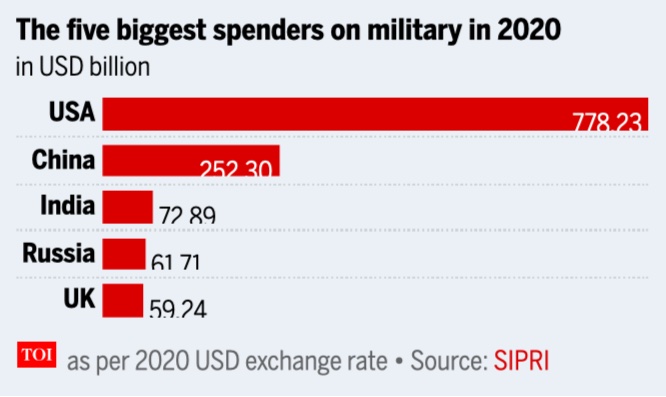
From: April 29, 2021: The Times of India
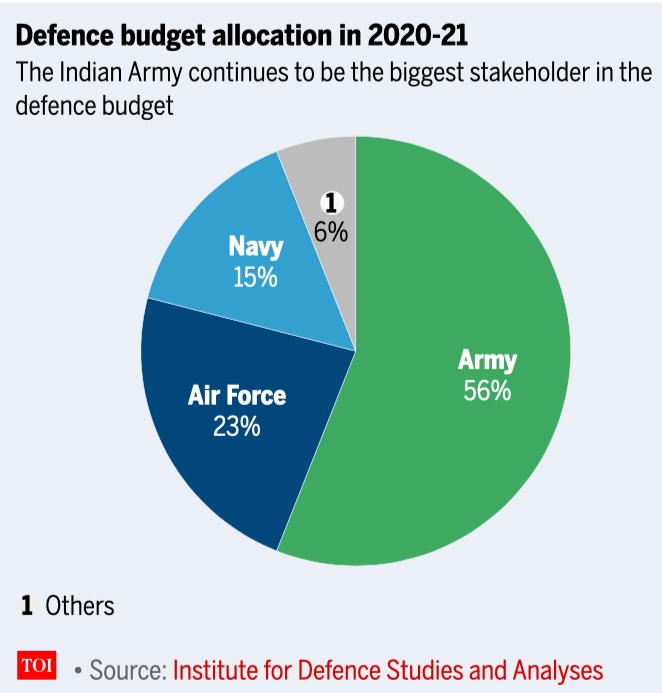
From: April 29, 2021: The Times of India
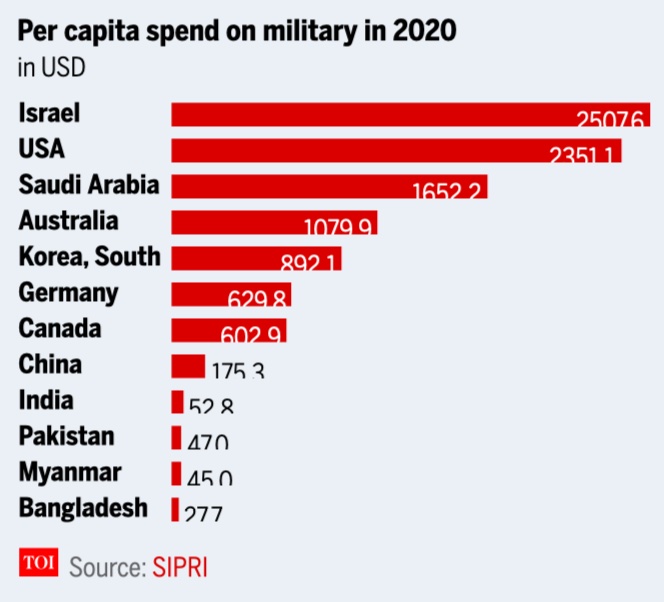
From: April 29, 2021: The Times of India
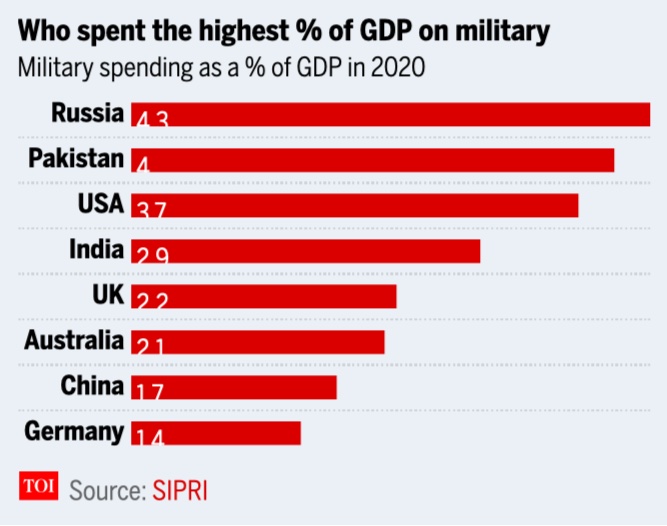
From: April 29, 2021: The Times of India
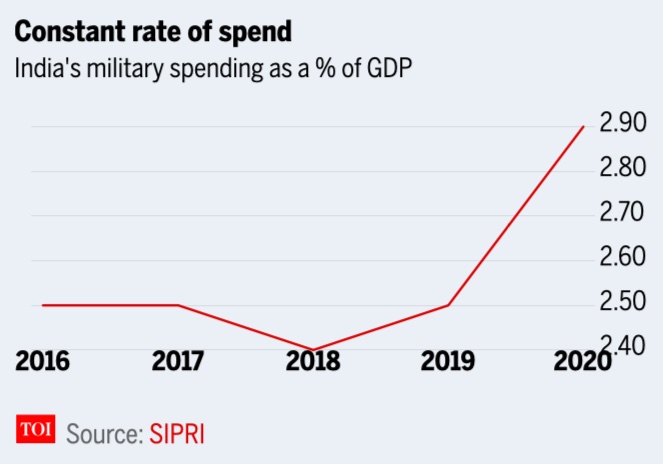
From: April 29, 2021: The Times of India
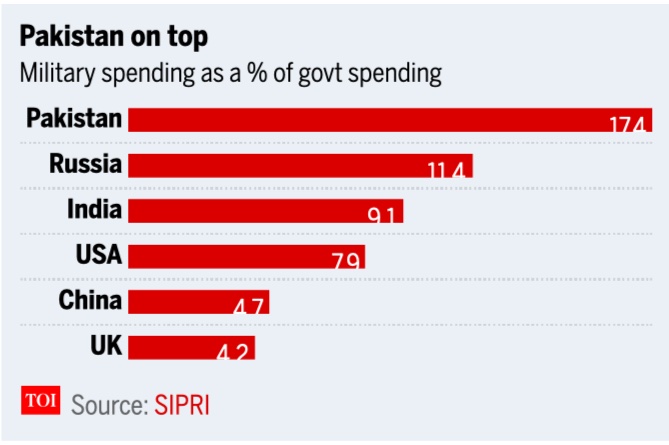
From: April 29, 2021: The Times of India
Data shows India’s spending on its military grew in 2020 despite the pandemic, but here’s what the finer details reveal
A long-running conflict with China ensured India spent more than 2019 on its defence forces and remained the third highest spender on its military in 2020. However, India remains far behind neighbour Pakistan and others when it comes to certain aspects of military spending.
The latest data released by the Stockholm International Peace Research Institute (SIPRI) showed that India may be the third highest spender on the military in the world, but is far behind China and the US. While India spent an estimated $72 billion on its military, China spent nearly four times ($252 billion). The US spent nearly 10 times more than India, with a military spend of $778 billion dollars.
As The Times of India’s Rajat Pandit had noted, India’s annual military expenditure includes a huge pension bill for 33-lakh million veterans and defence civilians.
In the 2021-2022 defence budget, the pension bill was Rs 1.15 lakh crore out of the total Rs 4.78 lakh crore outlay.
India has to maintain defence forces with nearly 15 lakh personnel because of its two active and unresolved borders with China and Pakistan. As a result, the revenue expenditure for the day-to-day running costs and salary bill outstrips its spending on military modernisation. The Indian Army - with the highest number of personnel gets the lion’s share of India’s defence budget.
The extent that India spends on its extensive manpower is also reflected on the smaller amount it spends per person. While India is estimated to have spent $52.8 per person in 2020, nations like Israel, US, Saudi Arabia and Australia spend far more per person.
Where Pakistan beats India (but there’s no cause for worry)
Data on military spending as a percentage of the country’s total economic output or Gross Domestic Product showed that Russia, Pakistan and the US were ahead of India. While India spent 2.9% of its GDP on its military, Russia and Pakistan spent 4.3% and 4% of their GDP on their defence forces.
While Pakistan spent a higher percentage of its GDP on its defence forces, its total military spend is $10.3 billion, and it’s ranked 23rd in the list of countries.
The data shows that India’s spending as a percentage of GDP rose in 2020 in spite of the pandemic, but has otherwise stayed nearly constant for the last five years. The continuing military confrontation with China in eastern Ladakh had caused India to make several emergency arms purchases from abroad after the crisis erupted in early-May last year.
SIPRI also said India’s defence expenditure can largely be attributed to its ongoing tensions with Pakistan over Kashmir and renewed border tensions with China. There is also India’s “more general rivalry with China as the main regional power in Asia and Oceania”, it said.
Data for military spending as a percentage of total government spending also showed that India was far behind Pakistan which spends nearly 18% of its government funds on its defence forces. However, it was ahead of the US, UK and China.
2018

From: Nov 26, 2019: The Times of India
See graphic:
2018: Defence expenditures made by in India, China, France, Germany, Japan, Russia, S Arabia, South Korea, the UK and the USA
2020
Rajat Pandit, April 27, 2021: The Times of India
India remains the third biggest military spender in the world, though far behind the US that spends more than 10 times and China almost four times its defence budget.
The total global military expenditure rose to $1,981 billion in 2020, an increase of 2.6% in real terms from 2019 despite the global gross domestic product contracting by 4.4% mainly due to the Covid pandemic’s economic impact, says the latest data released by global think-tank Stockholm International Peace Research Institute (SIPRI).
“We can say with some certainty that the pandemic did not have a significant impact on global military spending in 2020. It remains to be seen whether countries will maintain this level of military spending through a second year of the pandemic,” said Dr Diego Lopes da Silva of SIPRI.
The 10 biggest military spenders were the US ($778 billion), China ($252 billion), India ($72.9 billion), Russia ($61.7 billion), UK ($59.2 billion), Saudi Arabia ($57.5 billion), Germany ($52.8 billion), France ($52.7 billion), Japan ($49.1 billion) and South Korea ($45.7 billion).
The top five together accounted for 62% of the global military expenditure. China’s military expenditure, in particular, grew for the 26th consecutive year, with its uninterrupted increase being the largest by far among the top 15 countries over the 2011-2020 decade. Pakistan ($10.3 billion), in turn, was ranked 23rdin the list.
India’s annual military expenditure, of course, includes a huge pension bill for 33-lakh million veterans and defence civilians. In the 2021-2022 defence budget, for instance, the pension bill was Rs 1.15 lakh crore out of the total Rs 4.78 lakh crore outlay.
India also has to maintain an over 15-lakh strong armed forces because of the two active and unresolved borders with China and Pakistan. Consequently, the revenue expenditure for the day-to-day running costs and salary bill in the defence budget by far outstrips the capital outlay for military modernization, leaving critical operational shortages on different fronts, ranging from fighters to submarines.
The continuing military confrontation with China in eastern Ladakh, of course, has led India to make several emergency arms purchases from abroad since the crisis erupted in early-May last year.
SIPRI, on its part, said India’s defence expenditure can largely be attributed to its ongoing tensions with Pakistan over Kashmir and renewed border tensions with China. Then, there is also India’s “more general rivalry with China as the main regional power in Asia and Oceania”, it said.
With a weak domestic defence-industrial base, India of course continues to languish in the strategically-vulnerable position of being the world’s second-largest arms importer just behind Saudi Arabia. India accounted for 9.5% of the total global arms imports during 2016-2020.
2021
Rajat Pandit, April 26, 2022: The Times of India
New Delhi: India remains ahead of Russia and the UK as the third largest military spender in the world, but far behind China that spends four times and the US which spends 10 times its defence budget. The total global military expenditure rose to $2,113 billion in 2021, surpassing the two trillion US dollar mark for the first time despite the economic shocks of the Covid-19 pandemic, as per the latest data released by global think-tank Stockholm International Peace Research Institute (SIPRI) on Monday. The five largest spenders were the US ($801 billion), which accounted for 38% of the world military spending, China (estimated $293 billion), India ($77 billion), UK ($68 billion) and Russia ($66 billion). Pakistan was placed at the 23rd spot with $11 billion. While China’s actual military expenditure remains shrouded in secrecy, SIPRI noted it has steadily grown for 27 consecutive years, the longest uninterrupted sequence of hikes by any country in its database. “India’s spending was up by 0. 9% from 2020 and by 33% from 2012. Amid ongoing tensions and border disputes with China and Pakistan that occasionally spill over into armed clashes, India has prioritised the modernisation of its armed forces and self-reliance in arms production,” said SIPRI. While SIPRI does not go into details, India certainly does not get the requisite bang for its buck. The country’s military modernisation continues to be hampered by a ballooning revenue expenditure for day-to-day running costs and salaries for the 15-lakh strong armed forces as well as a massive pension bill. India’s Rs 5. 2 lakh crore defence budget for 2022-2023, for instance, includes the huge Rs 1. 2 lakh crore pension bill for the over 33 lakh retired military and defence civilians. Moreover, the Rs 2. 3 lakh crore revenue expendi- ture dwarfs the Rs 1. 5 lakh crore capital allocation for overall modernisation and new weapon systems. Then, the lack of concrete long-term plans to systematically build military capabilities with proper inter-Service prioritisation as well as the weak domestic defence-industrial base compounds the problem. Consequently, the forces continue to grapple with critical shortages on several fronts, ranging from fighters, submarines and helicopters to drones, anti-tank guided missiles and night-fighting capabilities. The two-year-long military confrontation with China in eastern Ladakh, as with other border crises in the past, has led to a flurry of emergency procurement by the Army, Navy and IAF from abroad. The government has taken some steps to get India out of its strategically-vulnerable position as the world’s largest arms importer, accounting for 11% of the global weapons imports, but they are yet to take off in any substantial manner. There is also the need for the 12-lakh strong Army to slash its non-operational flab for a better teeth-to-tail ratio, though the requirement for adequate ‘boots on the ground’ will continue for the two long-unresolved borders with China and Pakistan.
2024
Rajat Pandit, April 29, 2025: The Times of India

From: Rajat Pandit, April 29, 2025: The Times of India
New Delhi : India is the fifth-largest military spender globally, spending almost nine times more than Pakistan. But it also has to contend with China, another nuclear-armed neighbour which spends almost four times more.
With the global military expenditure registering the steepest year-on-year increase since the end of the Cold War to reach a record $2,718 billion due to ongoing conflicts and geopolitical turmoil, India is ranked after the US, China, Russia and Germany.
The global military expenditure increased by 9.4% in real terms in 2024, with the top five spenders accounting for 60% of the total with a combined spending of $1,635 billion, as per the latest data released by the Stockholm International Peace Research Institute (SIPRI).
The report comes at a time when the ceasefire along the Line of Control with Pakistan has frayed after the Pahalgam terror massacre, while China continues with its forward deployment of over 100,000 troops along the Line of Actual Control though disengagement has taken place in eastern Ladakh.
“India is probably the only country with two active and long unresolved borders with nuclear-armed neighbours. We must cater for both,” a senior Indian military officer told TOI . SIPRI said the 10 largest military spenders are US ($997 billion), China ($314 billion), Russia ($149 billion), Germany ($88 billion), India ($86 billion), UK ($82 billion), Saudi Arabia ($80 billion), Ukraine ($65 billion), France ($65 billion) and Japan ($55 billion). Pakistan was placed at the 29th spot with $10bn.
India may be a big military spender but somewhat flounders in getting the biggest bang for its buck despite the two-front challenge. Just around 22% of the Rs 6.8 lakh crore ($80 billion) annual defence budget for 2025-26, for instance, is earmarked for capital procurements of new weapon systems and platforms. The rest is gobbled up by salaries and day-to-day operational costs for the 1.4-million-strong armed forces as well as the huge pension bill for over 3.4 million ex-servicemen and defence civilians.
India spends just 1.9% of its GDP on defence when at least 2.5% is needed to effectively deal with the collusive threat from China and Pakistan. Apart from the relatively weak defence-industrial base, which makes India the second largest arms importer in the world, another major problem is the relative absence of concrete longterm plans to systematically build military capabilities in tune with the country’s geopolitical aspirations.
Consequently, the armed forces continue to grapple with major operational shortages on several fronts, ranging from fighters, submarines and helicopters to air defence systems, antitank guided missiles and night-fighting capabilities. China is rapidly modernizing its two-millionstrong military across the traditional domains of land, air and sea as well as nuclear, space and cyber, recording its 30th consecutive year-on-year hike in its official military budget, which experts say is far less than what it actually spends. Pakistan also is no pushover.
“China, the world’s second-largest military spender, allocated an estimated $314 billion to its military in 2024, up by 7% from 2023. This was the largest year-onyear percentage increase in China’s military spending since 2015,” SIPRI said. China “unveiled” several improved military capabilities in 2024, including new stealth combat aircraft, unmanned aerial vehicles (UAVs) and uncrewed underwater vehicles. “China also continued to rapidly expand its nuclear arsenal in 2024 and moved to strengthen certain types of counter-space and cyberwarfare capabilities. It established separate aerospace and cyberspace forces in 2024,” it added.
Equipment
Shortage of items: Indian Army
2015
Army needs 4L balaclavas, 2L boots
Chethan Kumar, Jan 08 2015
With one of the worst winters in the pipeline, the Indian Army is facing a shortage of items like high-ankle boots and balaclavas, lakhs of which still need to be procured. Air Marshal PP Reddy , chief of Integrated Defence Staff,said India needs to be prepared for war on both fronts, China and Pakistan. But how equipped are our soldiers in high-altitude regions? The third report of the standing committee on defence 2014-15, submitted on December 22, 2014 points that there's a shortage of 2.17 lakh boots (high ankle), 4.47 lakh balaclavas and 65,978 durries (thick cotton quilts), all basic requirements in high-altitude areas. Besides, there's a shortage of 13.09 lakh canvas shoes and mosquito nets.
Member of Parliament from Belagavi and committee member Suresh Angadi told TOI, “This has been plaguing the Army for a while now. Even when Atal Bihari Vajpayee was Prime Minister, strict instructions were given by the government to procure all the necessary articles for soldiers but it has not happened. Even now, we've told officials to expedite the pro curement process.“
The report quoting ViceChief of Army Staff (VCOAS) Lt Gen Philip Campose on how the Army is managing the Mountain Strike Corps given the lack of equipment, says the Army is falling back on war wastage reserves. “We are holding War Wastage Reserves of all sorts of equipment, weapons, and stores.All this has been taken out from the WWR and given to the new raisings,“ he told the committee.
The defence ministry has set March 16, 2015 as deadline for procurement of the items.
See also
Defence imports, arms imports: India, Pakistan
Defence procurement: South Asia
Defence production, India: 2 (ministry data)
